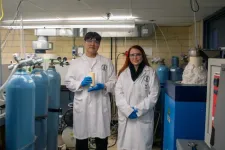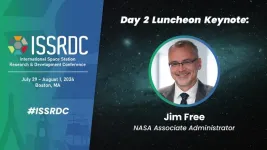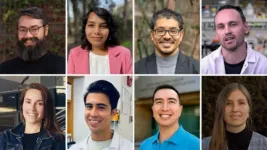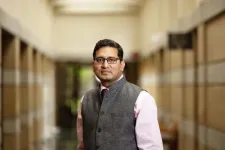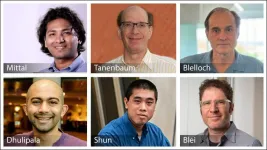(Press-News.org) University of Toronto engineering researchers have designed a new way to recycle steel that has the potential to decarbonize a range of manufacturing industries and usher in a circular steel economy.
The method is outlined in a new paper published in Resources, Conservation & Recycling and co-authored by Jaesuk (Jay) Paeng, William Judge and Professor Gisele Azimi.
It introduces an innovative oxysulfide electrolyte for electrorefining, an alternative way of removing copper and carbon impurities from molten steel. The process also generates liquid iron and sulfur as by-products.
“Our study is the first reported instance of electrochemically removing copper from steel and reducing impurities to below alloy level,” says Azimi, who holds the Canada Research Chair in Urban Mining Innovations.
Currently, only 25% of steel produced comes from recycled material. But the global demand for a greener steel is projected to grow over the next two decades as governments around the world endeavour to achieve net-zero emission goals.
Steel is created by reacting iron ore with coke — a prepared form of coal — as the source of carbon and blowing oxygen through the metal produced. Current standard processes generate nearly two tonnes of carbon dioxide per tonne of steel produced, making steel production one of the highest contributors to carbon emissions in the manufacturing sector.
Traditional steel recycling methods use an electric arc furnace to melt down scrap metal. Since it is difficult to physically separate copper material from scrap before melting, the element is also present in the recycled steel products.
“The main problem with secondary steel production is that the scrap being recycled may be contaminated with other elements, including copper,” says Azimi.
“The concentration of copper adds up as you add more scrap metals to be recycled, and when it goes above 0.1 weight percentage (wt%) in the final steel product, it will be detrimental to the properties of steel.”
Copper cannot be removed from molten steel scrap using the traditional electric arc furnace steelmaking practice, so this limits the secondary steel market to producing lower-quality steel product, such as reinforcing bars used in the construction industry.
“Our method can expand the secondary steel market into different industries,” says Paeng.
“It has the potential to be used to create higher-grade products such as galvanized cold rolled coil used in the automotive sector, or steel sheets for deep drawing, used in the transport sector.”
To remove copper from iron to below 0.1 wt%, the team had to first design an electrochemical cell that could withstand temperatures up to 1600 degrees Celsius.
Inside the cell, electricity flows between the negative electrode (cathode) and the positive electrode (anode) through a novel oxysulfide electrolyte designed from slag — a waste derived from steelmaking that often ends up in cement or landfills.
“We put our contaminated iron that has the copper impurity as the anode of the electrochemical cell,” says Azimi.
“We then apply an electromotive force, which is the voltage, with a power supply and we force the copper to react with the electrolyte.”
“The electrolyte targets the removal of copper from the iron when we apply electricity to the cell,” adds Paeng.
“When we apply electricity on the one side of the cell, we force the copper to react with the electrolyte and come out from iron. At the other end of the cell, we simultaneously produce new iron.”
Azimi’s lab collaborated with Tenova Goodfellow Inc., a global supplier of advanced technologies, products and services for metal and mining industries. Looking forward, the team wants to enable the electro-refining process to remove other contaminants from steel, including tin.
“Iron and steel are the most widely used metals in the industry, and I think the production rate is as high as 1.9 billion tonnes per year,” says Azimi.
“Our method has great potential to offer the steelmaking industry a practical and easily implementable way to recycle steel to produce more of the demand for high-grade steel globally.”
END
This new way to recycle steel could reduce the industry’s carbon footprint
University of Toronto Engineering professor Gisele Azimi and her lab group have designed a new electrochemical pathway to remove contaminants such as copper from steel scrap
2024-06-18
ELSE PRESS RELEASES FROM THIS DATE:
Journal of Nutrition recognizes distinguished Texas A&M nutrition scientist
2024-06-18
MEDIA INQUIRES
WRITTEN BY
Laura Muntean
Paul Schattenberg
laura.muntean@ag.tamu.edu
paschattenberg@ag.tamu.edu
601-248-1891
210-859-5752
FOR ...
Non-native plants and animals expanding ranges 100 times faster than native species, finds new research led by UMass Amherst
2024-06-18
June 18, 2024
Non-native Plants and Animals Expanding Ranges 100 Times Faster than Native Species, Finds New Research Led by UMass Amherst
Native species cannot move fast enough on their own to avoid climate-driven chaos
AMHERST, Mass. – An international team of scientists has recently found that non-native species are expanding their ranges many orders of magnitude faster than native ones, in large part due to inadvertent human help. Even seemingly sedentary non-native plants are moving at three times the speed ...
NASA Associate Administrator Jim Free to deliver keynote address at ISSRDC
2024-06-18
BOSTON (MA), June 18, 2024 – Jim Free, associate administrator for NASA, will deliver a keynote address on Wednesday, July 31, at the International Space Station Research and Development Conference (ISSRDC) in Boston. Free, the senior advisor to Administrator Bill Nelson and Deputy Administrator Pam Melroy, is NASA’s third highest-ranking executive and its highest-ranking civil servant. In addition to leading the agency’s 10 center directors and the mission directorate associate administrators at NASA Headquarters ...
Cost may not keep many people from filling opioid addiction treatment prescriptions
2024-06-18
When people get a prescription for the opioid addiction medication called buprenorphine, they almost always fill it — even if they have to pay more out of their own pocket, a new study shows.
Whether it’s their first prescription for the medication, or they’ve been taking it for months, nearly all patients pick up the order from the pharmacy, according to the new findings from a University of Michigan team. Even among those just starting on buprenorphine, higher costs aren’t a deterrent.
The researchers say this suggests that removing barriers ...
Fred Hutch announces eight recipients of 2024 Dr. Eddie Méndez Scholar Award
2024-06-18
SEATTLE — June 18, 2024 — Fred Hutch Cancer Center announced the recipients of the 2024 Dr. Eddie Méndez Scholar Award, which recognizes outstanding early-career scientists from underrepresented backgrounds who are studying cancer, infectious diseases and basic sciences.
The eight postdoctoral awardees come from research institutions across the U.S. and are experts in a range of subjects including cancer immunology, fungal model systems and craniofacial development.
“We enthusiastically congratulate this year’s recipients who were chosen from a very competitive pool of candidates,” said Christina Termini, PhD, MM, co-director ...
NASA selects Lockheed Martin to build next-gen spacecraft for NOAA
2024-06-18
NASA, on behalf of the National Oceanic and Atmospheric Administration (NOAA), has selected Lockheed Martin Corp. of Littleton, Colorado, to build the spacecraft for NOAA’s Geostationary Extended Observations (GeoXO) satellite program.
This cost-plus-award-fee contract is valued at approximately $2.27 billion. It includes the development of three spacecraft as well as four options for additional spacecraft. The anticipated period of performance for this contract includes support for 10 years of on-orbit operations and five years of on-orbit storage, for a total of 15 years for each spacecraft. ...
C-Path partners with FARA to fortify RDCA-DAP and further accelerate drug development with new Friedreich’s Ataxia Data
2024-06-18
TUCSON, Ariz., June 18, 2024 — Critical Path Institute (C-Path), a leader in accelerating drug development for rare diseases, today announced the targeted integration of additional Friedreich’s ataxia (FA) datasets into C-Path’s Rare Disease Cures Accelerator-Data and Analytics Platform (RDCA-DAP®) as part of a partnership with Friedreich’s Ataxia Research Alliance (FARA).
This update includes data from two natural history studies; the FA-CHILD study, which focuses on pediatric ...
Rigorous new study debunks misconceptions about anemia, education
2024-06-18
In low- and middle-income countries, anemia reduction efforts are often touted as a way to improve educational outcomes and reduce poverty. A new study, co-authored by a global health economics expert from the University of Notre Dame, evaluates the relationship between anemia and school attendance in India, debunking earlier research that could have misguided policy interventions.
Santosh Kumar, associate professor of development and global health economics at Notre Dame’s Keough School of Global Affairs, is co-author of the study, published in Communications ...
Existing high blood pressure drugs may prevent epilepsy, Stanford Medicine-led study finds
2024-06-18
A class of drugs already on the market to lower blood pressure appears to reduce adults’ risk of developing epilepsy, Stanford Medicine researchers and their colleagues have discovered. The finding comes out of an analysis of the medical records of more than 2 million Americans taking blood pressure medications.
The study, published June 17 in JAMA Neurology, suggests that the drugs, called angiotensin receptor blockers, could prevent epilepsy in people at highest risk of the disease, ...
ACM recognizes innovators who solve real world problems
2024-06-18
ACM, the Association for Computing Machinery, today announced the recipients of four prestigious technical awards. These four awards in diverse categories celebrate the hard work and creativity which underpin many of today’s most important technologies.
Prateek Mittal, Princeton University, is the recipient of the 2023 ACM Grace Murray Hopper Award for foundational contributions to safeguarding Internet privacy and security using a cross-layer approach.
The unifying theme in Mittal’s ...
LAST 30 PRESS RELEASES:
Longest observation of an active solar region
Why nail-biting, procrastination and other self-sabotaging behaviors are rooted in survival instincts
Regional variations in mechanical properties of porcine leptomeninges
Artificial empathy in therapy and healthcare: advancements in interpersonal interaction technologies
Why some brains switch gears more efficiently than others
UVA’s Jundong Li wins ICDM’S 2025 Tao Li Award for data mining, machine learning
UVA’s low-power, high-performance computer power player Mircea Stan earns National Academy of Inventors fellowship
Not playing by the rules: USU researcher explores filamentous algae dynamics in rivers
Do our body clocks influence our risk of dementia?
Anthropologists offer new evidence of bipedalism in long-debated fossil discovery
Safer receipt paper from wood
Dosage-sensitive genes suggest no whole-genome duplications in ancestral angiosperm
First ancient human herpesvirus genomes document their deep history with humans
Why Some Bacteria Survive Antibiotics and How to Stop Them - New study reveals that bacteria can survive antibiotic treatment through two fundamentally different “shutdown modes”
UCLA study links scar healing to dangerous placenta condition
CHANGE-seq-BE finds off-target changes in the genome from base editors
The Journal of Nuclear Medicine Ahead-of-Print Tip Sheet: January 2, 2026
Delayed or absent first dose of measles, mumps, and rubella vaccination
Trends in US preterm birth rates by household income and race and ethnicity
Study identifies potential biomarker linked to progression and brain inflammation in multiple sclerosis
Many mothers in Norway do not show up for postnatal check-ups
Researchers want to find out why quick clay is so unstable
Superradiant spins show teamwork at the quantum scale
Cleveland Clinic Research links tumor bacteria to immunotherapy resistance in head and neck cancer
First Editorial of 2026: Resisting AI slop
Joint ground- and space-based observations reveal Saturn-mass rogue planet
Inheritable genetic variant offers protection against blood cancer risk and progression
Pigs settled Pacific islands alongside early human voyagers
A Coral reef’s daily pulse reshapes microbes in surrounding waters
EAST Tokamak experiments exceed plasma density limit, offering new approach to fusion ignition
[Press-News.org] This new way to recycle steel could reduce the industry’s carbon footprintUniversity of Toronto Engineering professor Gisele Azimi and her lab group have designed a new electrochemical pathway to remove contaminants such as copper from steel scrap
